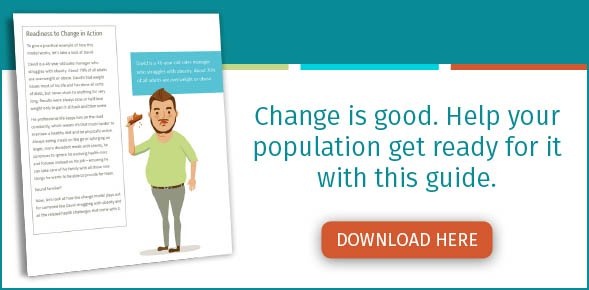The average adult in the United States works 44 to 47 hours a week. For some, even 50 or 60 is likely on the low side of the hours clocked. Of course, you know how work affects day-to-day life—snooze alarm, harried commute, then settle into the office chair for a full day—but what impact does work have on overall health?
 It isn’t just the time spent at work that impacts the lives of more than 100 million working adults—it’s the entire culture and environment of the job which can have a massive impact on population health. In this post we’ll examine two ways that workplace culture can impact population health and provide suggestions for how to make modifications to improve wellness across the board.
It isn’t just the time spent at work that impacts the lives of more than 100 million working adults—it’s the entire culture and environment of the job which can have a massive impact on population health. In this post we’ll examine two ways that workplace culture can impact population health and provide suggestions for how to make modifications to improve wellness across the board.
A Culture of Sitting
At many organizations it’s completely normal to arrive at work, sit down at a desk to start the day, and not really get up again until it’s time to leave. Whether it’s because there’s so much to do or because there’s just no reason to get up, the fact of the matter is no one’s moving—and that’s not good. According to a 2018 systematic review published in the European Journal of Epidemiology, long periods of sedentary time correlate with a higher rate of death. Similarly, the American Heart Association advises that regardless of the amount of time spent exercising each day, long periods of sitting could “negatively impact the health of your heart and blood vessels.”
As luck may have it, this could be a fairly easy area to help improve your population’s health. By encouraging your population to make it a point to move more during the workday—as frequently as every 30 minutes—you could be doing them a huge favor. Of course, it’s not always enough to simply make the suggestion and move on. If a workplace has a deeply ingrained culture of working at a desk straight through until quitting time, it’s unlikely that people will suddenly embrace (or believe…) a suggestion to spend a bit of time stretching, walking around, or chatting. It should, therefore, be a practice that’s exemplified by leadership so that everyone throughout the “org chart” is exposed to the culture change.
Here are a few ways to encourage your population to get moving at work:
- Schedule walking meetings and brainstorming sessions if possible.
- Send a fun email every so often that encourages everyone to stop what they’re doing and stretch for a couple minutes.
- Suggest that employees get up and walk over to whomever they need to have a quick conversation with rather than using IM or email.
- Start meetings with a couple group stretches.
Chronic High Stress
Another major contributor to ill-health and chronic disease is chronic high stress. Stress, in its intended biological form, is actually good for us. The short bursts of adrenaline allow us to move quickly out of dangerous situations or use our physical strength at maximum output. But long-lasting stress can lead to a weakened immune system, chronic diseases such as diabetes, obesity, and cardiovascular disease, and on-the-job injuries. It’s estimated that 80% to 90% of all industrial accidents are related to personal problems and employees’ inability to handle stress.
Just about every individual is going to experience stress at their job at one time or another, but how long that stress lasts and how it’s handled could make a big difference. To help your population properly manage their stress here are some policies and practices that can be put into place:
- Encourage your population to utilize the sick and vacation time available to them—and actually mean it!
- Emphasize the importance of setting work/life boundaries. For example, the vast majority of emails don’t need to be answered after-hours and should wait until morning.
- Provide resources on stress-management techniques such as yoga, meditation, mindfulness, exercise, and even conflict resolution.
- If possible, partner with a fitness center to provide a membership discount to your population.
Additionally, providing a health risk assessment to your population can help them realize that they may be at risk for certain chronic illnesses and take the appropriate steps with their healthcare provider to minimize the effects.
Are you ready to help your population make some changes? Download our guide, Change Readiness: The Critical Component to Wellness Engagement, below.








